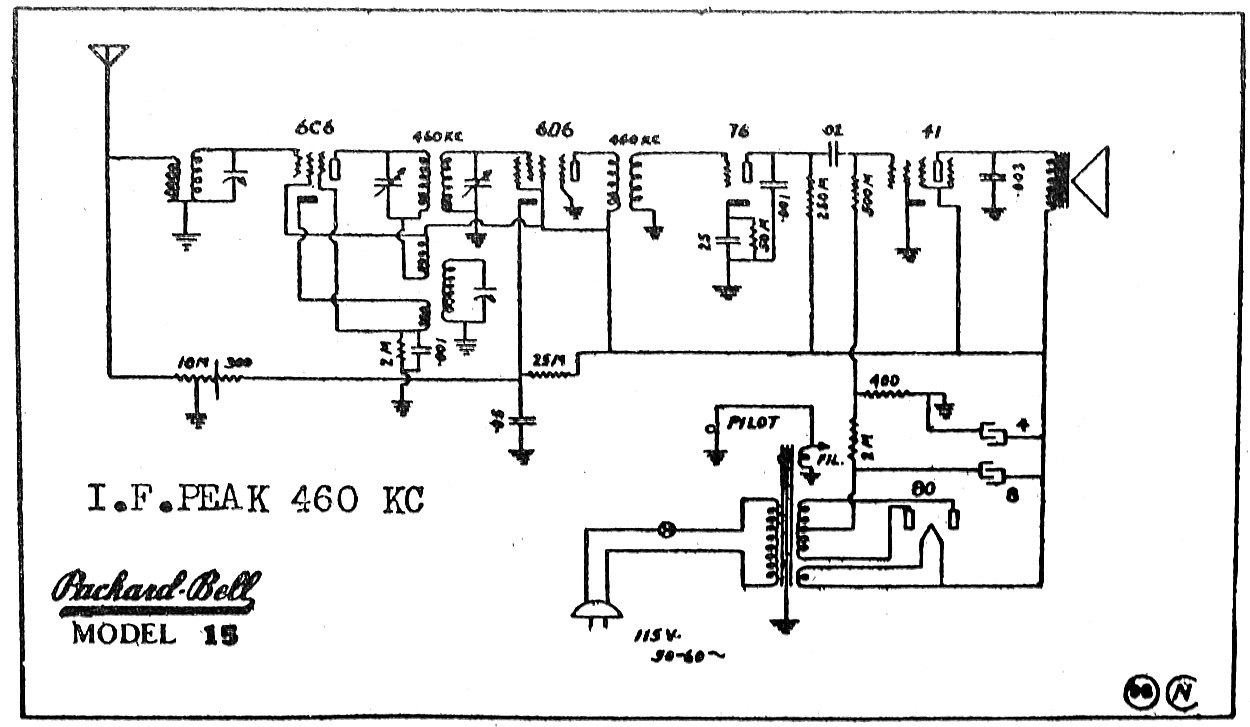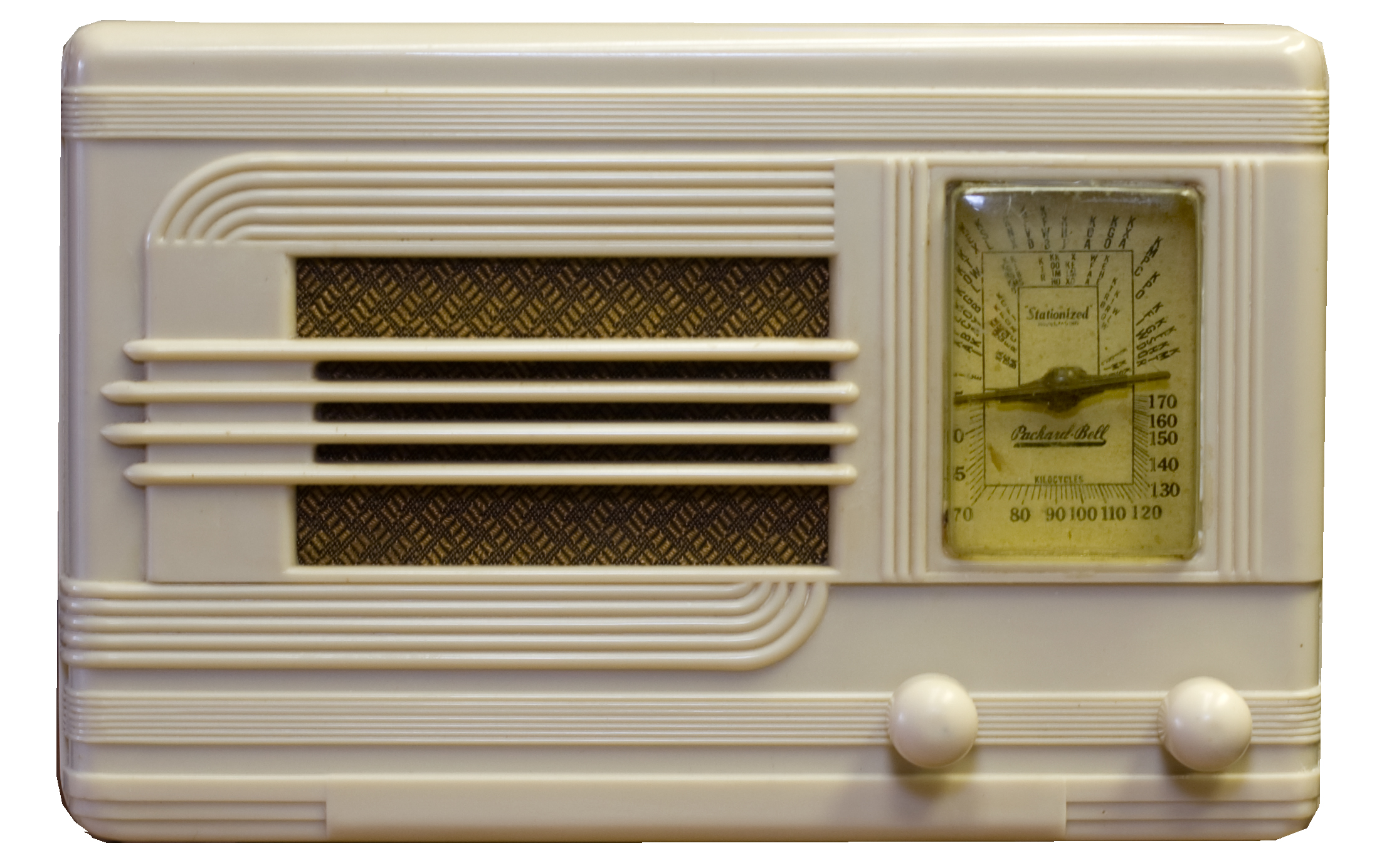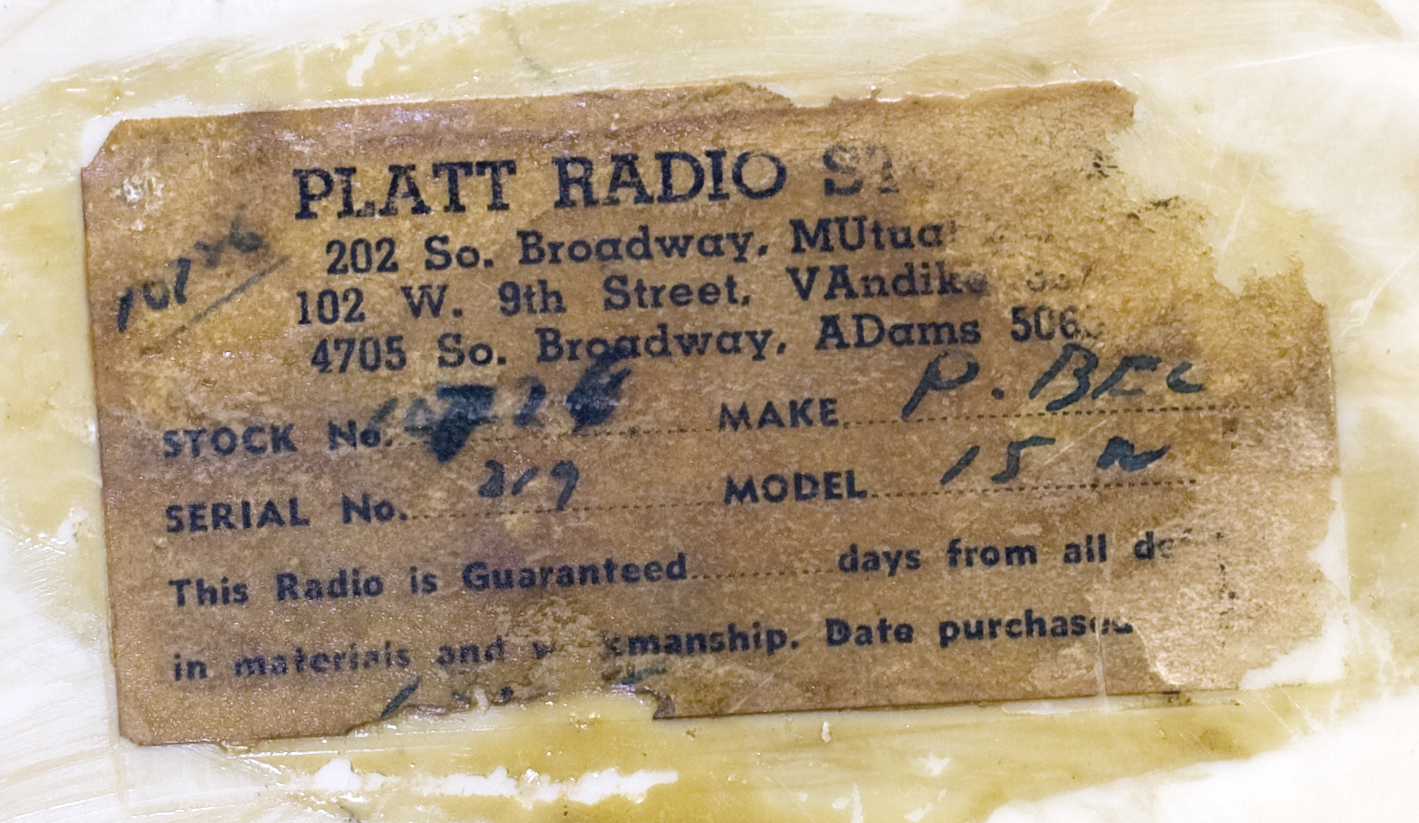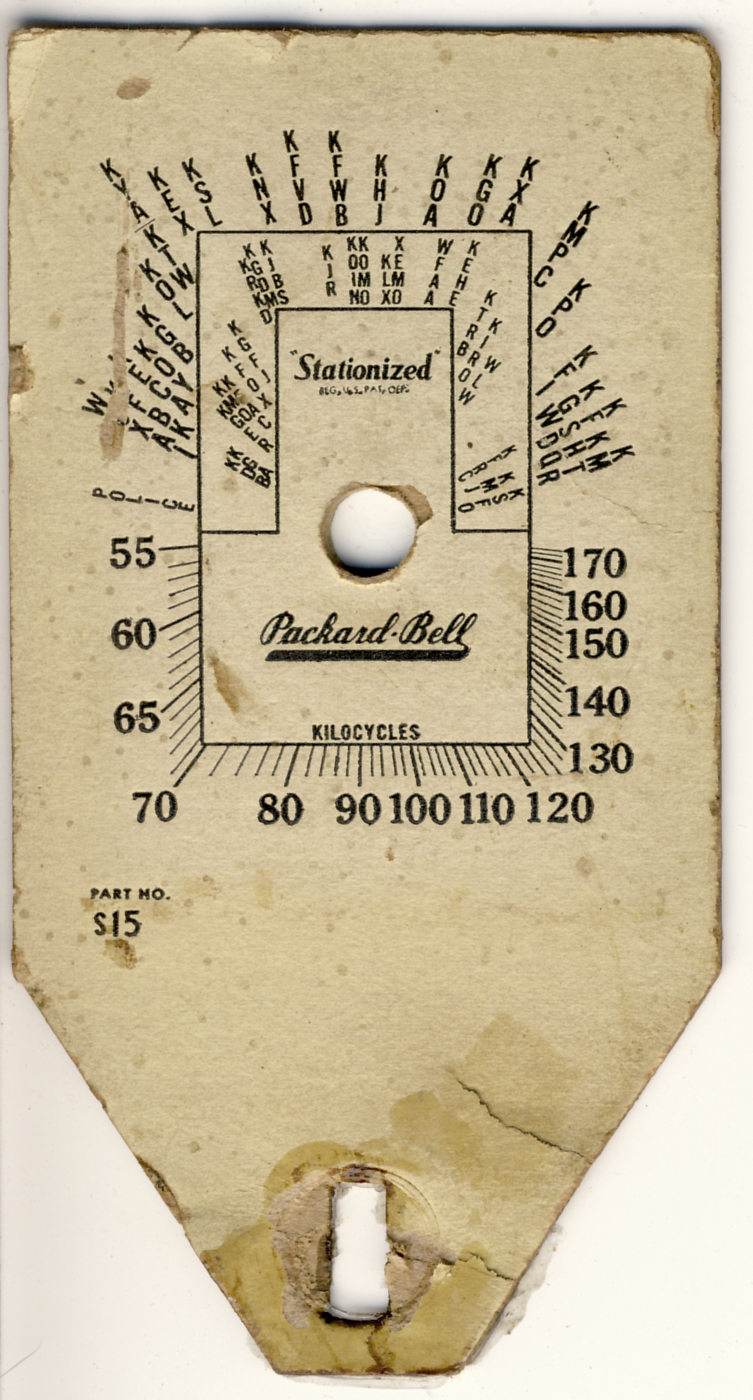
Note: This radio is no longer part of my collection. This page is being left up for reference only.
What I know about Packard Bell and this radio you can fit in a space the size of the logo to the left. But I won't let that stop me.
Packard-Bell was a Los Angeles-based company with distribution in the Western US, so they came up with a gimmick that works if you have a regional customer base: they marked their dials with the call letters of the big, clear-channel stations in the west. The idea was that if you wanted KFI, you just turn the pointer to KFI, and you didn't have to remember that it was really 640. Supposedly (according to Wikipedia) that was so Bell's mom could read the dial. On my Model 15 the dial is so small Chuck Yeager would have squinted to read it. But whatever.
This particular model appears to have a long life, at least cosmetically. The earliest version I've seen is this Model 15 with five "pre-octal" tubes. There's an ad on Radiomuseum for a "Kompak," same cabinet but with an octal tube lineup, and there's a Model 100 with the same cabinet and a 12 volt tube compliment. There are various tweaks, but I get the impression this is one of those models where they wringed every cent out of it that there was to be had.
The service docs for this particular model (pre-octal) is limited to a quarter-page schematic in Rider's Perpetual Troubleshooting Manual, Volume 10. The scans I've seen on the internet are not great. As I'm fortunate enough to have a dead tree edition of that volume, I've got a slightly better copy. Click on it to view a larger size.
Some of the values are still hard to read and a few are missing outright. But I do know that M, at this time, is K for us now (i.e. that's not a 10 Meg volume-control pot in the lower left). I've been trying to re-draw it in more modern style (namely the tubes). If I come up with a good one, I'll put that here too.
I'm not going to do a day-by-day log the way I have with the bigger projects; I've just been doing bits and pieces as a change of pace while working on the Trans-Oceanic.
Here's the cabinet. This is after I cleaned it up with Awesome, Meguiar's plastic polish, and a little Turtle Wax.
There's a remnant of a sticker on the bottom of the cabinet:
The cabinet is vinyl or something like it—it's not hard enough to be Catalin or Bakelite. I'm pretty sure the speaker cloth was replaced because it looks way too clean for something this age (and considering the condition the rest of the radio is in). When I took the chassis out, a lot of the caps looks familiar, so I assume The Old Man probably worked this over at one time or another.
The chassis comes out easy: pull the two front knobs off and remove two screws in the bottom. The dial and the speaker are mounted directly to the chassis so there's nothing to disconnect.
Five tubes: a 6C6 converter, 6D6 IF amp, 76 2nd detector, 41 audio out and an 80 rectifier. Testing them on my Hickok was interesting. Everything tested fine except the 80 and the 41. The 80 is a full-wave rectifier and the Hickok said one side was strong but the other side was weak. For the 41 I was simply s-o-l as it didn't appear on the roll-chart at all. I could consult the manuals and probably work out the settings to test it anyway, but I went a different route.
 I have three tube testers; five if you count the Seco GCT-5, which is a speciality tester, but only three if you discount the Seco 107, which is not trustworthy. So I pulled them out. The 41 doesn't appear on my Eico's roll-chart either, but it was in the Sylvania 140's directory. The 41 tested good in the Sylvania, so I thought I'd try the 80: it tested good on both sides.
I have three tube testers; five if you count the Seco GCT-5, which is a speciality tester, but only three if you discount the Seco 107, which is not trustworthy. So I pulled them out. The 41 doesn't appear on my Eico's roll-chart either, but it was in the Sylvania 140's directory. The 41 tested good in the Sylvania, so I thought I'd try the 80: it tested good on both sides.
Two things to take away from this.
Regarding the 41: how many tube testers do you need? As many as you can get.
- Regarding the 80, this is one of my favorite sayings: a man who has one watch always knows what time it is; a man who has two watches never knows what time it is.
Signal Tracing
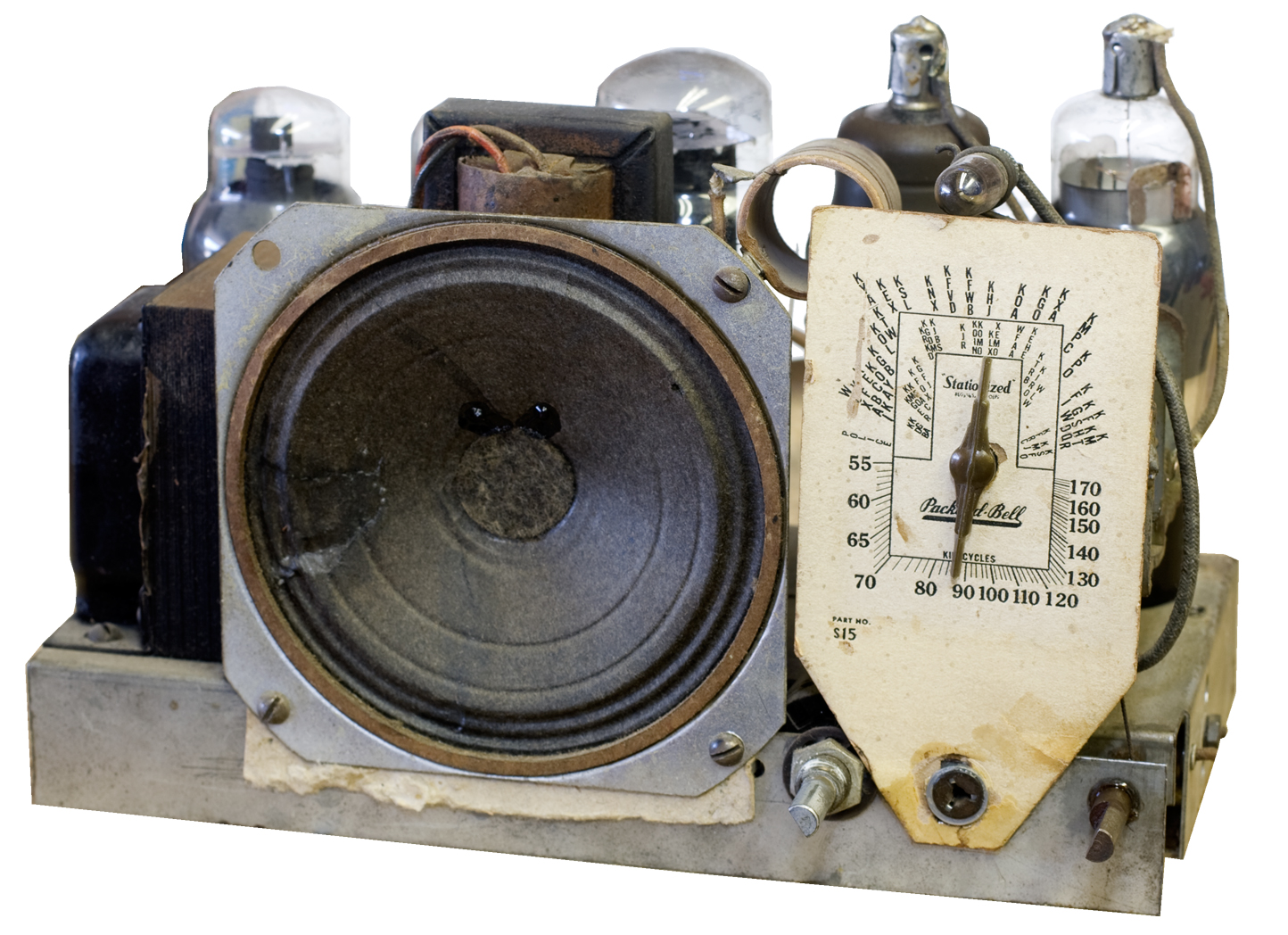
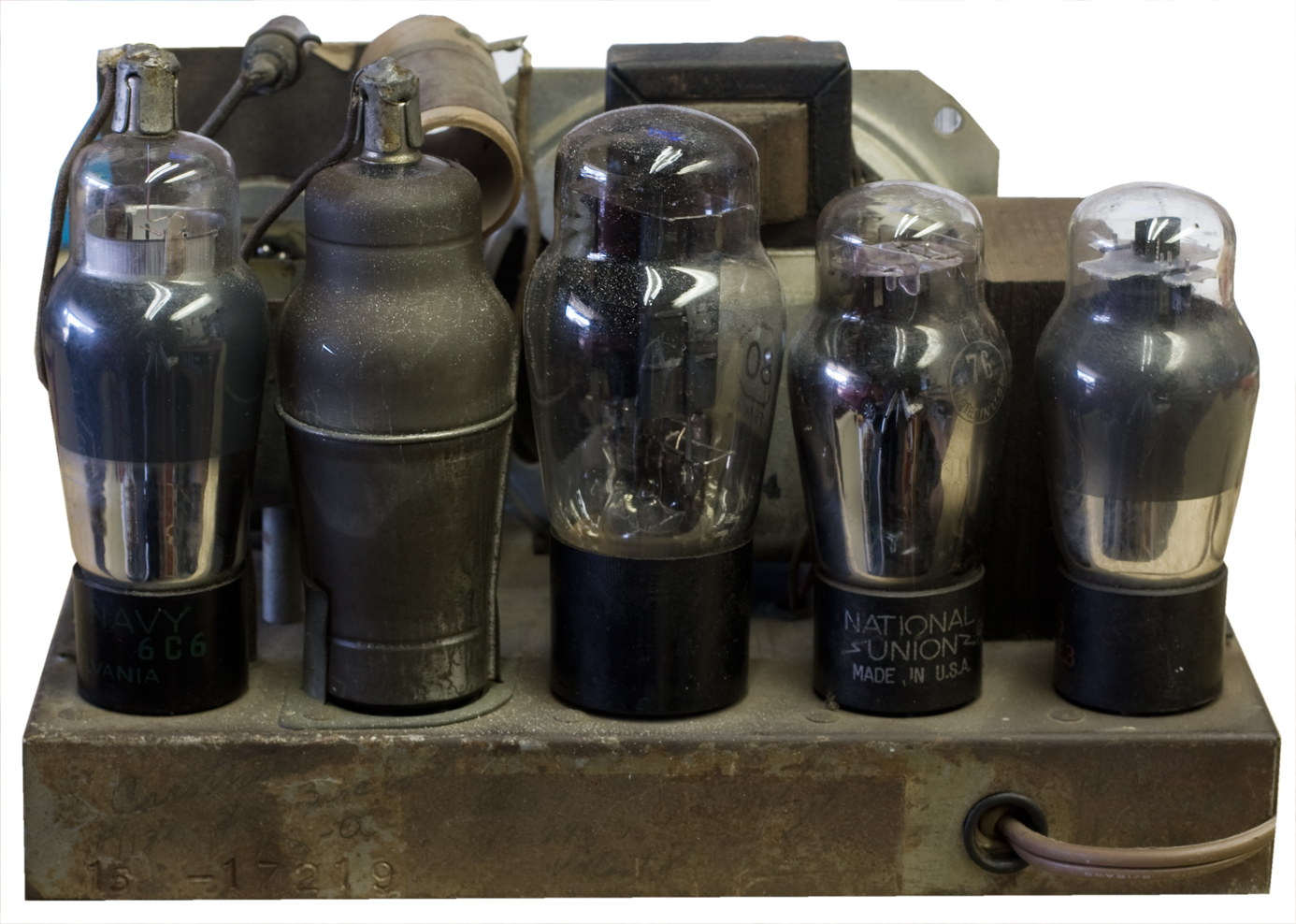
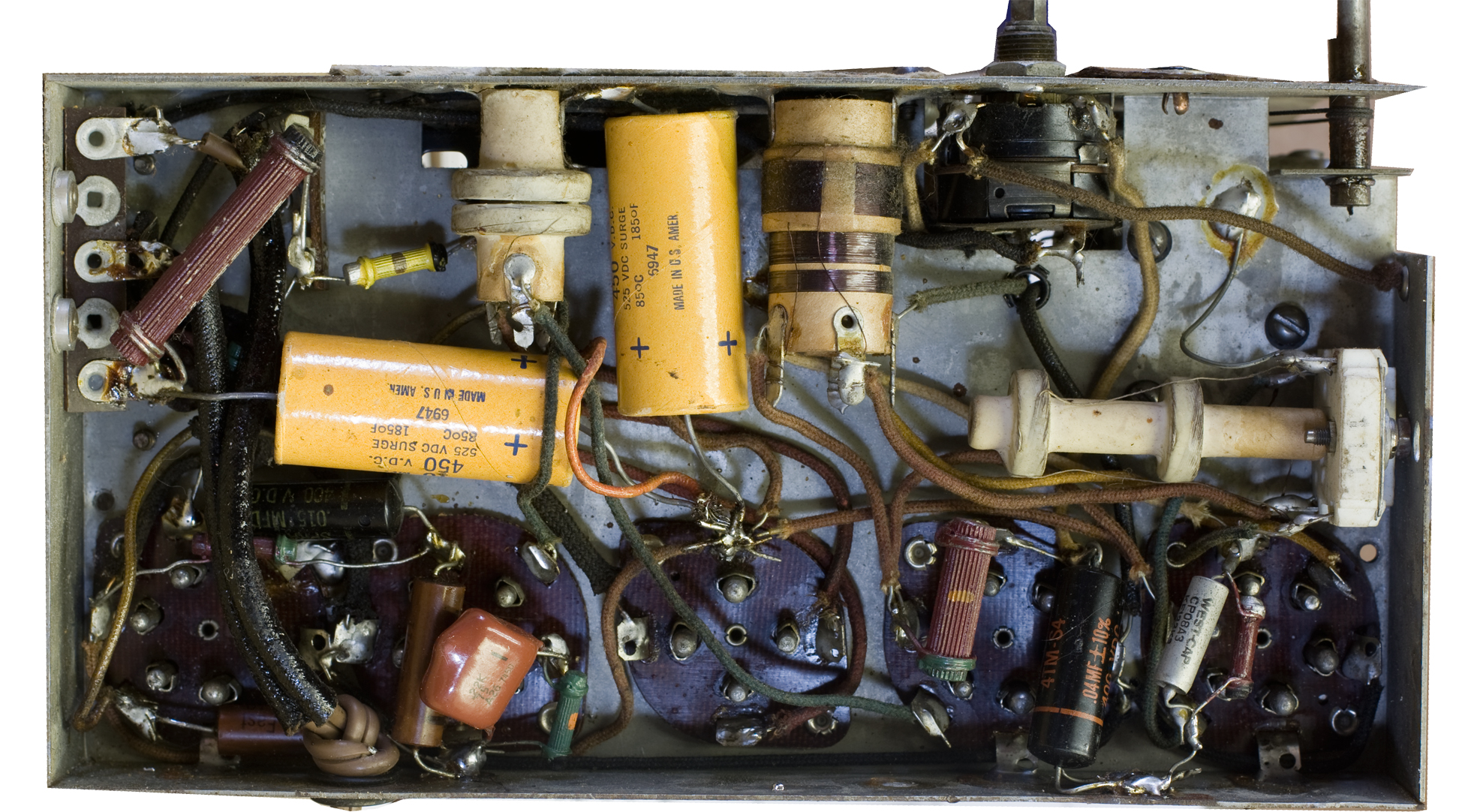
Initially the radio seemed dead, but the audio out definitely works. I could hear noise as I touched the volume pot wiper. So I put the signal generator on it and began working backward, and seemed to lose it going into the IF amp.
There are two holes in the chassis side (under the tuning section) where you can adjust the IF alignment, and I was able to bring the audio up considerably. Now I could hear a signal when I injected it into the antenna wire, but still no stations. I fussed with the air/variable cap trimmers and got a little improvement, but still nothing that doesn't come from the generator. Since the generator runs pretty hot, I'm assuming the problem now is that the set is seriously weak.
I took a quick reading of B+ but I'm hindered by the fact that the schematic doesn't say what to expect. My 1934 RCA manual has plate voltages on the 6D6, for example, at both 100 and 250V (max for the latter): that's quite a spread.
Next step is to check filament voltages—maybe I'm low everywhere. Maybe the C- is too high. Or ?
Or maybe not. A week ago I had pulled the tubes to help determine where the pins were in the socket (these are pre-octals, it's not easy to determine where Pin 1 is when you're looking at the underside of the socket), and in the process I broke the grid cap off of the 6C6. I made a mental note to look up what kind of glue to use (glass to tin or some simlar base metal) and promptly forgot about it. I didn't break it off completely so it wasn't exactly flopping around, but when I was signal-tracing, it was not making good contact and I hadn't noticed. Not until today when I touched it and remembered it was broken.
As usual on the net there were several suggestions, and I decided to go with super glue. The 6C6 doesn't run that hot so I wasn't so concerned with that. Super glue appears to be holding it nicely, and with a makeshift antenna, I was able to pick up a couple of strong stations.
The next step is to fix the slack dial cord (below), put the face and pointer back on, tack on a better antenna and try aligning it again.
The tuner control was working fine until I got it out of the cabinet and started messing with it, and now the dial cord is just slack enough that it slips on the control shaft. The only thing I can figure is that I wet the cord while I was spraying things with spray contact cleaner, and the cord is now slack. Rosin didn't help. The spring is fully retracted, so the plan is to nip the cord and try to re-tie it to the spring, which should take just enough slack out to make it work again. I've tried that sort of thing before with no success; odds are I'll have to re-string it.
In order to get to the spring, I had to remove the dial face. The pointer nearly fell off, it was so loose. The card was held in place by—I don't know what it's called—kind of a thumb rivet. I think it's missing a piece that's like a thumbtack with a bigger center post: you push it in and it expands the outer shroud that's behind the sheet metal. This thing was long gone so the card was tacked into place with glue. I gently pulled that off with a razor. I scanned the card, which is in pretty good condition, in case anyone wants it. Click the picture for a full-size image.
I put the card back into place and stuck the rivet in, but it was too loose to do anything useful. I ended up tacking it in place with a dab of superglue.
2nd Alignment
I had figured it would be more-or-less aligned but no way. I could pick up the Vientnamese flame-thrower in the area and nothing else, except for a godawful heterodyne squeal around 700 kHz. Initially I was afraid I had a problem with a coil or something else I'd never be able to determine or fix, but I tried another alignment just to see what would happen. This time I shorted out the local oscillator section of the tuner cap and injected 460 kHz (this radio's IF) and peaked it. I re-enabled the oscillator, set the dial to 1320 (where the vietnamese station is) and peaked the oscillator timmer. Now I could get three big stations, one high (vietnamese), KLAA at 830 and KFI at 640. And no more squeal.
Still Playing
I put the chassis back in, put the knobs back on, and fired it off. It still works! Picks up the three stations. Without a loopstick or an external antenna hookup, I figured that is all I can ask.
This project is done.
Current status: no longer in my collection

